A BIRCH TOO FAR
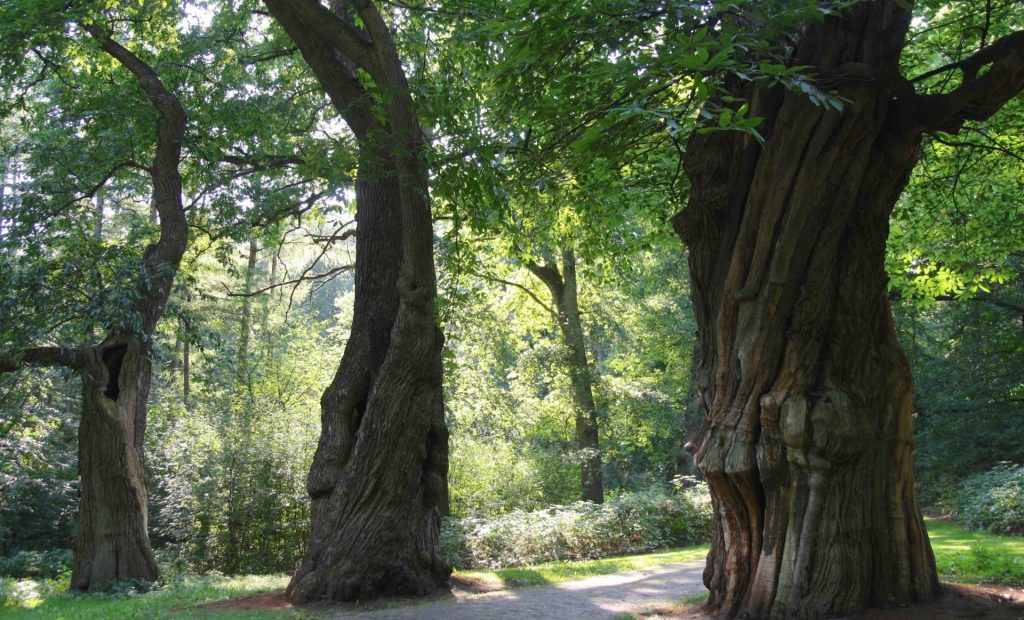
One of the pleasures of planning walks in the early Boots and Bowtie days using the old (read “paper”) topographic maps was spotting the symbol which according to the map legend indicated a “remarkable tree”. This would mean a tree that conspicuously differs from the ones around it, or is in a spot where it functions as a landmark. We often used this as a structural point of a walk if not an outright goal.
Recently we’ve come to appreciate trees much more than we already did (and written about a few in recent posts). Let’s face it, trees are pretty remarkable in the first place. Many have withstood centuries of adverse weather and/or distortion, bullets and other abuses from human hands. But some have been valued and allowed to grow to magnificence.
There seems to be a growing world community of tree-spotters. The Netherlands has the luck to have a foundation (the Bomenstichting) that keeps a national register of monumental and historic trees, in Dutch but pretty easy to find your way around. You can find the “top ten” noteworthy trees in each province, or just choose a pin on the map and see what sort of tree it is (we look up the common name in Wikipedia, then look at the English page for that tree, or google the Latin name if there isn’t one). There is also a site, bomeninfo.nl., with an English version. And the Netherlands-based Monumentaltrees.com, which despite its name doesn’t have an English page, is helpful if you want to find looking up trees all over the world.
The town of Arnhem is remarkable for having scads of hilly green space, most of it former estates owned by wealthy Amsterdam families. We’ve designed a route that takes in four remarkable trees or groups of trees in and around Arnhem. This is a perfect walk for a hot sunny day when you don’t want too much sunshine. The gastronomic interest is six (!) cafés/restaurants in Sonsbeek Park. It’s almost at the end, so take what you need for the first 12 km with you, or do the walk backwards. You can also bail earlier and hit any number of spots in the center of town before catching a train back.
Practical info:
Length: approx. 15.5 km
Start: Wolfheze station
End: Arnhem Central station
Terrain: hilly, shaded in summer
Gastronomic: six café-restaurants in Sonsbeek Park (and other possibilities off route including Hoeve Klein Mariëndaal)
Remarks: mostly unpaved
Bailing options:
A – start at Oosterbeek station (miss Wodanseiken);
B – go from Sonsbeek to Arnhem Central (miss the Dalweg oak)
The trees, in order we visited them:
Wodanseiken – a group of oaks made famous (and given the nickname) by a group of 19th-century painters
De Groene Bedstee (“the green box bed”) – 650 meters of beeches woven together so that ladies could walk outdoors without getting sun on their faces
De Poortwachters (“gatekeepers”) three sweet chestnuts “guarding” the road from Huize Zijpendal
The Oak on the Dalweg, simply magnificent with a 35-meter-wide crown
The walk itself:
The first part of the route lies along a regional footpath (yellow/red markings) which is part of the NS route Warnsborn, which we did in the other direction (map and directions here – note directions are in Dutch, and we did the walk in reverse. Also note you can use this route to get to Arnhem station from the pub if you skip the Dalweg tree).
From Wolfheze, leave the smallish station and go left – it looks unlikely but right away you’re walking alongside forest. Follow the yellow/red markings until you come to a paved road. Turn left, leaving the yellow/red route, and cross over the motorway, then take a path going off to the left and down the hill (actually the one to the right will get you there too), go left at a T intersection near a tunnel then right at the “duizenjarige den” (literally “thousand-year-old fir”, no longer a living tree, but manifestly feeding the cycle of life), and soon you’ll join the yellow/red-marked route again, going through the parking lot of the Fletcher Hotel and crossing the road.

Enter the forest, follow the red/yellow markings and at one point you’ll be across the stream bed looking at a picturesque grove of oak trees – the sign will tell you these are the Wodanseiken.
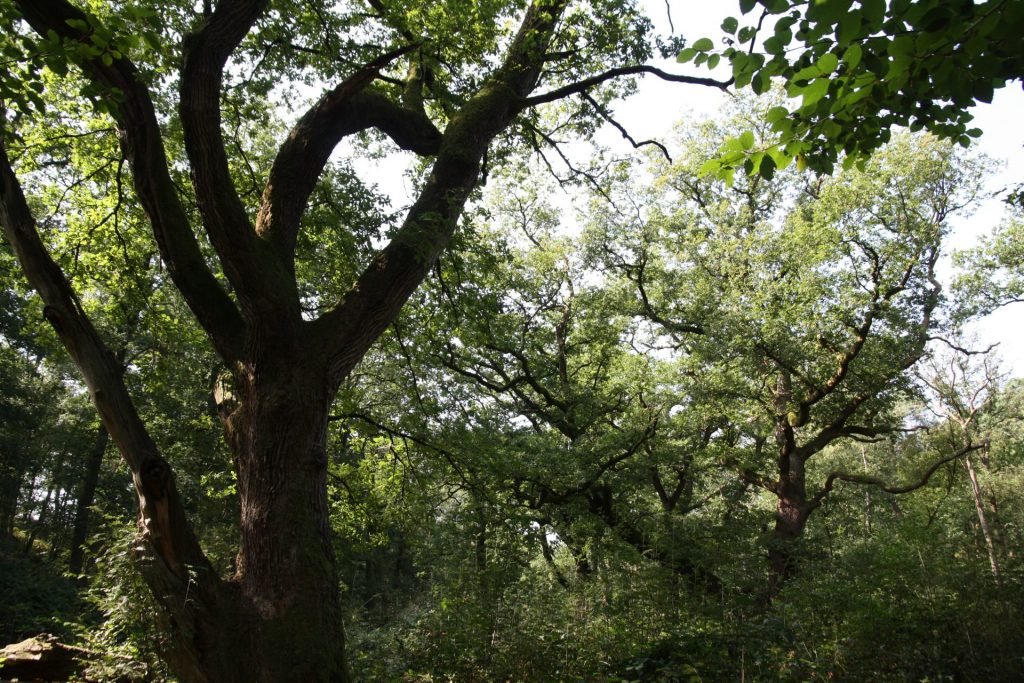
To continue, backtrack to the thousand-year-old fir, where you joined the red/yellow from the path down the hill. Stay on the red/yellow for about 4 kilometers. You’ll cross over the rail line at Oosterbeek station (now you’ll use map 2).
Bail-out (or -in) option: You can start the walk at Oosterbeek station. Exit the station and head towards Arnhem, with the rail line on your right and the military cemetery on your left.

Keep going, now with the tracks on your right. After the military cemetery the yellow/red route will turn left, but you keep going with the tracks on your right until you come out of the woods at an overpass. Cross over it, turn left and take your first right down the hill into Mariëndaal. At the bottom of the hill you can take a hard or soft left; take the soft left and you’ll see, and then enter, a tunnel made of interwoven small beech trees that goes on and on up the hill – the ‘Groene Bedstee’.
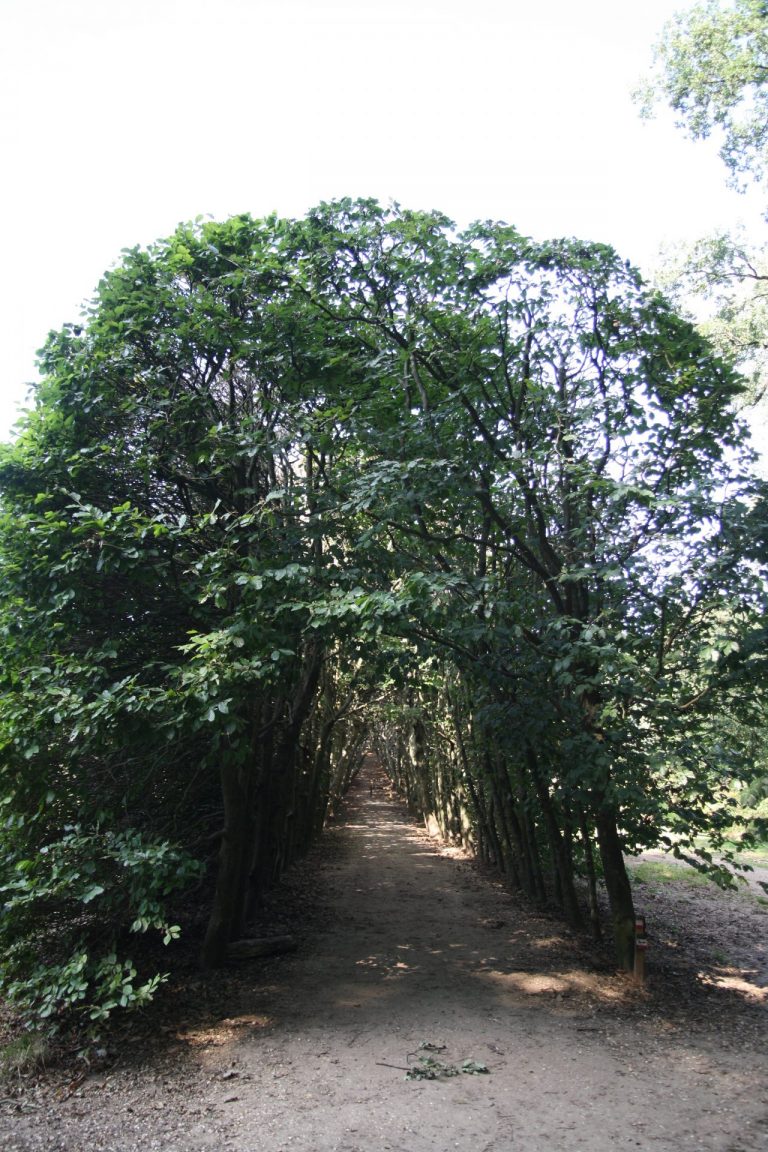
The one tree that is not a beech is a linden, right at a bench, which you might appreciate about now. (The linden is the tree for lovers, so why not put a bench there?) Take your time, and enjoy these writhing branches.

There is a place to get some refreshment in Mariëndaal, called Hoeve Klein Mariëndaal. A “zorgboerderij” offering activities to people with disabilities, it also has a little café. We haven’t been there but it sounds like a good thing.
Continue through this tunnel of trees up the hill. At the top, you can sneak out and take the path along a field. Head towards the busy road and cross it; you’ll enter the Mesdaglaan and take it all the way, about 700 meters (transitioning to map 3). You’ll come to a T intersection at Bakenbergseweg. Cross it and you’ll see a path a little off to the right. Take it into the forest; you’re entering the “Gulden Bodem” (roughly “golden ground”).

The path descends to a road through a small parking lot. Turn left, and soon you’ll see some wonderfully gnarly trees, the Poortwachters (the 3 dots on map 3).
These three venerable chestnuts are said to have been planted in about 1650. If not for their being stationary you could say they’ve been around the block.
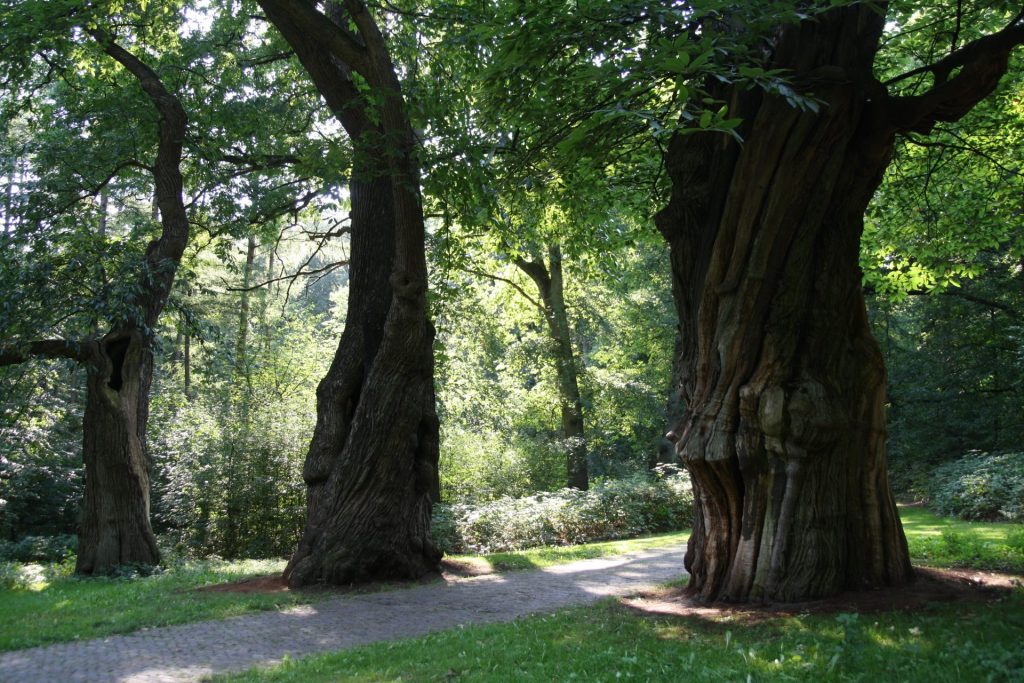
The widest of these is the thickest sweet chestnut in the Netherlands. Do spend some time to take in their gnarls and twists and missing limbs and pockmarks. What can we say? They have loads of character, and we only wish they could talk.
When you’re done admiring these guys, hit the road again, turn right and continue past the entrance to Kasteel Zijpendaal. (This is where you pick up the NS route again; the castle is landmark #4 on their map.) Bear left when you have a choice until you cross a stream. The food/drink options start here; all are along the route. Keep the stream on your right until the mill.
Food and drink stop: You have six options here, four by the stream and two just up the hill. (We have only been to Aan de Beek and De Palatijn, so we can’t vouch for the others.) Moving from up- to downstream, you have Sonsbeek Paviljoen (Chinese), Brasserie de Boerderij, and Grand Café Aan de Beek. This one, sharing a building with Netherlands Water Museum, has friendly service, yummy beers on tap and wines by the glass, and nice snacks, especially after 5:30 when the menu expands a little. Just a little further down is De Witte Molen, a working grain mill where you can buy flours and mixes (bah!), which also has a café (called A Beautiful Mess). It offers work to refugees, and the bread for their sandwiches is made from De Witte Molen’s flour. From either of these you can look uphill and see the Stadsvilla Sonsbeek, which also has a restaurant, and off the side of the villa yet another café-restaurant, De Palatijn.
Bailing option: To go to Arnhem Central station, go back down the Apeldoornseweg, keeping the park on your right until you get to the intersection with Zijpendaalseweg. Cross it and make a soft left heading towards the tunnel. Take a right onto a path right before the tunnel, and that will take you to Arnhem Central. You can also go back through the park if you feel able to navigate.
From here it’s not far to the majestic Pedunculate Oak on the Dalweg.
If you feel confident and/or have a mobile device with a way to navigate, you can take any number of paths through the trees to get out to the Apeldoornseweg. If you need a little more guidance, the from Café aan de Beek, walk downstream, and then left again on Zijpendaalseweg, then your first left onto a busy street which in a block or so becomes the Apeldoornseweg. If you’re up the hill at the Stadsvilla or Palatijn, find the path just uphill from where you are and turn right, and you’ll come to a park entrance between two small buildings. This is also the Apeldoornseweg; turn left.
Going uphill on Apeldoornseweg, turn right onto Dalweg, and the tree is about 200 meters on the left. There’s a footpath going in from the street (if you see an elementary school called “De Wijzer” on your left you’ve missed it). Once you’re on the path, the tree is only a few steps in, and you can’t miss it.
It is simply massive, and gorgeous. At 6.34 meters (that’s over 20 feet for those who don’t speak metric) around the trunk and 25 m (82 ft) high with a crown 35 meters (114 ft) wide, this is one of the country’s largest oak trees, and was probably planted mid-18th century. Beyond its obvious magnificence, there’s no plaque or bench or other outward sign that this is a Remarkable Tree, but you can use its roots for benches and a picnic table. Except that you probably just ate.
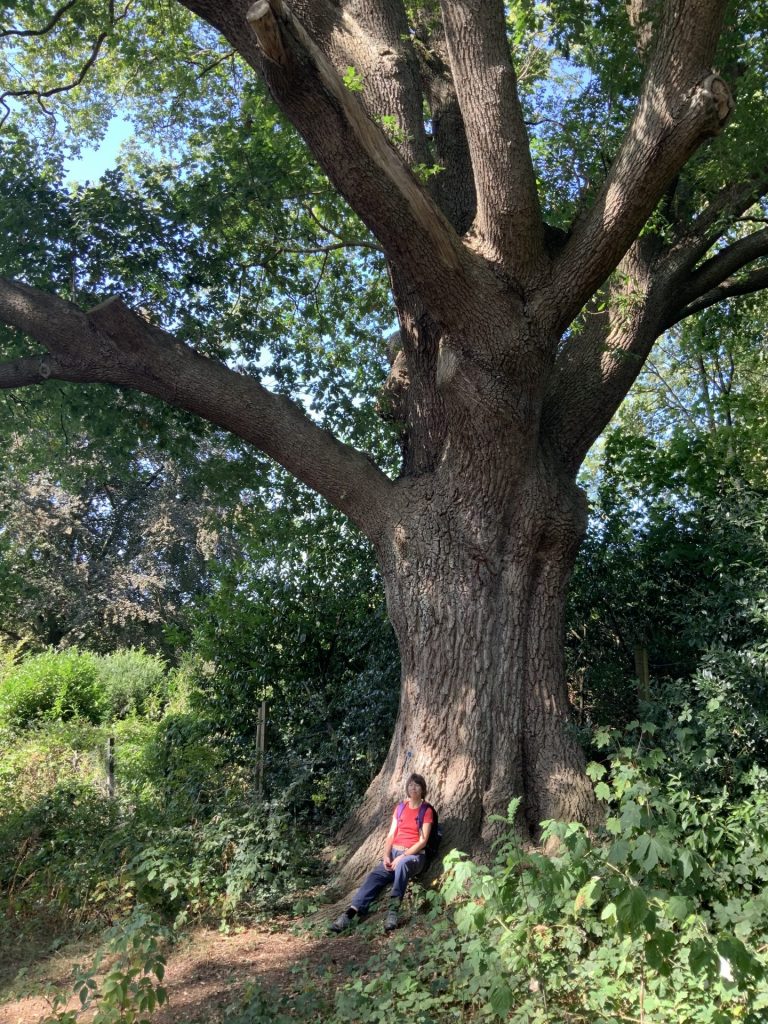
Time to go to Arnhem station. Go back through the park for the scenic route, otherwise head back down the hill on Apeldoornseweg, take a soft right, then you’ll see the tracks and turn right, and keep going until you see the station entrance.
We hope you enjoyed these extraordinary trees and Arnhem’s lovely parks, as much as we did. Please tell us about your experience – we welcome feedback.
